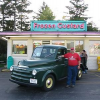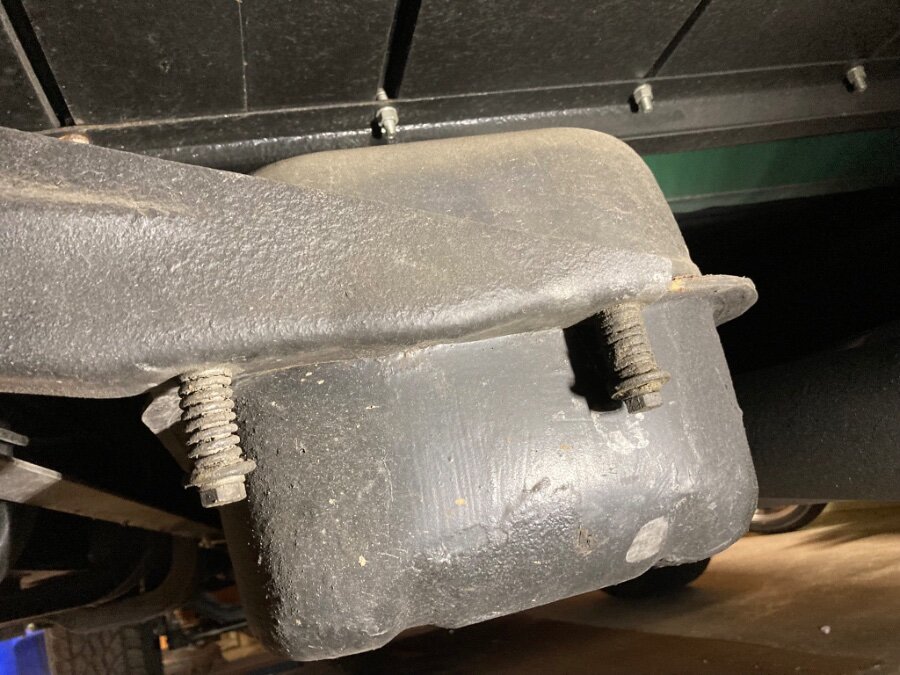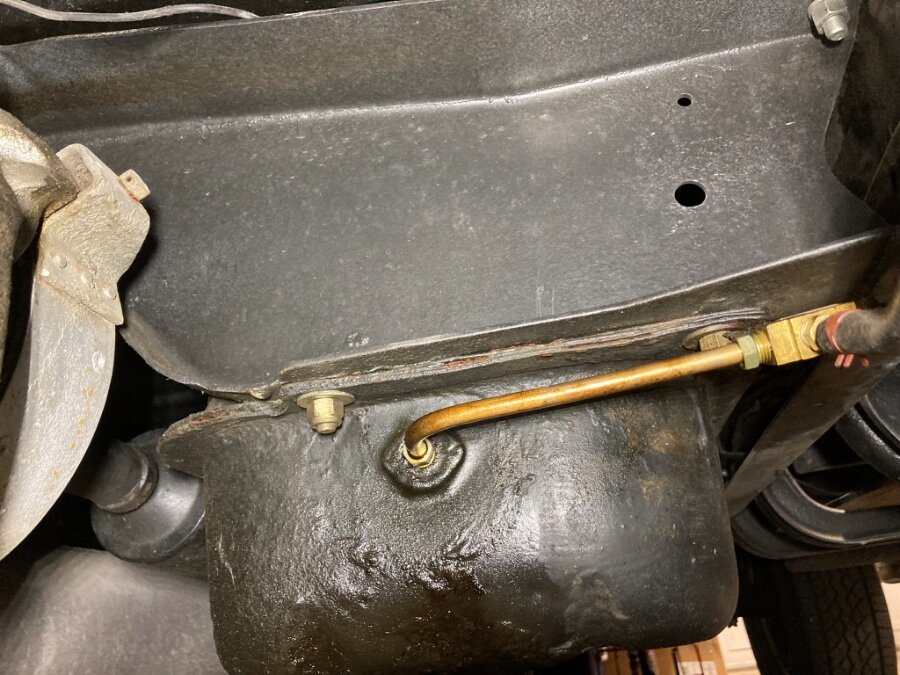-
Posts
9,370 -
Joined
-
Last visited
-
Days Won
86
Content Type
Links Directory
Profiles
Articles
Forums
Downloads
Store
Gallery
Blogs
Events
Everything posted by Merle Coggins
-
If they came loose after 10-20 years you probably have other issues, unless it hasn't run since it was rebuilt that long ago.
-
That looks like Jeramiah's (Ram Man 02) blue truck in the one picture... next to Joe's Route Van... probably at BTT50's
-
May also need to change the voltage regulator to match that Chev. gen.
-
It wouldn't hurt to do another re-torque later on.
-

51 B3B build thread - after all these years
Merle Coggins replied to bkahler's topic in Mopar Flathead Truck Forum
When I got my truck all together and running I didn't have the bed together yet. I hung some tail lights on the back of the frame and drove it around that weekend. I know what you mean about being bouncy without no weight on the back. Now it rides much better with the bed installed. -
I don't know if it's 'correct' or not, but I just go over them again with the torque wrench until they're up to torque.
-
From my shop manual... The 3 columns are for B, C, and D models. The D's had 230s and B and C's had 218s, so you can see that the valve clearance is the same between the 2 engines.
-

Clements Tailgate BBQ 16th Annual Event......
Merle Coggins replied to 48Dodger's topic in Mopar Flathead Truck Forum
-
@Ram Man 02, How's the progress on your truck? I often wonder how you're getting along with your diesel project.
- 698 replies
-

51 B3B build thread - after all these years
Merle Coggins replied to bkahler's topic in Mopar Flathead Truck Forum
Once you correct the clearance issue I would also recommend that you add some dry lube to all of the contact points on the linkage. I have found that over time my throttle will start to hang up a little. I'll get out my can of spray lube and hit all of the contact points and all will be good again for a while. -

How Do I Delete The Foot Starter On My 52 B3B Truck
Merle Coggins replied to 1rifleman's topic in Mopar Flathead Truck Forum
You'll need to get a starter from a Dodge or Plymouth of that same era. They use the push button start system. Then you'll need to add a start solenoid/relay in the engine bay to control the starter from the button that you install in the dash. -
Some say the rotor should point to the 7 O’Clock position at #1 TDC, but it all depends on how the oil pump and distributor was installed by the previous person. It could be pointing anywhere. Use some sandpaper, emery cloth, or Scotch-Brite pad to clean off the rust and crust on the outer edge of your crank pulley or damper to expose the timing marks. They are stamped in, but not easy to see without a good cleaning.
-
At #1 / #6 TDC the cam mark will either be right next to the crank gear mark, or directly across from it. In one position the #1 valves will be closed (#1 TDC Compression stroke) and in the other position the #6 valves will be closed (#6 TDC Compression stroke). Remember, the crank turns 2 complete revolutions for each revolution of the cam. Either way the marks should be lined up with the center lines of the 2 shafts when #1 and #6 are at TDC. If the pully mark is at 2 O'Clock with #1 and #6 at TDC then either, as stated in another post, the damper outer ring has slipped in relation to the inner hub, or this damper/pulley is made to work with a front cover that has the pointer at the 2 O'Clock position.
-
If the TDC mark is aligned with the pointer with the pistons in that position then there is certainly something wrong. Most likely a mismatched, or damaged, damper/pulley. If you lined up your crank and cam sprockets dot to dot then both #1 and #6 pistons should be at TDC and the valves on #6 should be closed (as I recall). You may want to remove the damper and cover to verify this, then recheck the alignment of the pulley/damper again without rotating the crankshaft.
-
Technically both statements could be flagged as “miss-information”. @billschwindt is correct in regards to the 23” engines but not for the 25” blocks. @wallytoo is correct in regards to the 25” engines only. I believe most, if not all, 25” blocks have the full flow filter mounting boss, but not all had them. Some were plumbed with by-pass filters. As for the larger 33” truck engines, we’d have to refer to @Dodgeb4ya
-
You’ll need to inspect the filter to see how it’s plumbed. I’ve seen those “Chrysler Full Flow Filter” decals for sale and someone may have stuck it on a bypass filter housing if you weren’t the one to restore your truck. What engine is in your truck? 23” engines, which would have been original in your truck, were never equipped with full flow filters.
-

clutch & brake pedal hitting floor boards
Merle Coggins replied to Mark G's topic in Mopar Flathead Truck Forum
I believe your truck is setup the same as the later B-series. There is no bushing in the clutch pedal, but they do tent to wear and get a bit of side-to-side movement, allowing the pedal arm to rub against the floor. Some have had success with removing the pedal and boring it round again and putting in a bushing to take up the play. Others just put a nylon rubbing block on the floor board for the pedal to rub against. -
Oil filters were an option for these trucks and many left the factory without one. My truck didn't have a filter when I got it. I found one on ebay to put on it as I was building it. There have been many that have plumbed in modern spin-on filters. They're probably better than nothing, but most filter elements used are made for full flow applications and don't have the fine filter media typically used in bypass filters. Also, a bypass filter needs to have a restriction built in to limit the amount of oil flow going through the filter. This prioritizes the oil feed to the critical engine components. The Chrysler flat head engines have this build into the oil pressure regulator, to restrict the return flow from the bypass filter if the oil pressure drops. But I would still use a restricted fitting in the system to limit the flow if you end up using a full flow type filter element. Amsoil has bypass filter kits for several applications, including a 'Universal' kit. https://www.amsoil.com/p/universal-single-remote-bypass-system-bmk21/ It's not cheap, but I know Amsoil sells quality stuff.
-
Did DCM stamp the numbers in for you too? My truck hasn't had a tag since I got it. I should probably get one.
-
Here's a couple pics from my B2C, which should be similar to your B2D Springs at the rear mount Bolted solid to the bottom of the cross member at the front.
-

Chrysler Rotating Recessed Crank with Radiator stand in-place
Merle Coggins replied to wagoneer's topic in P15-D24 Forum
Did you try tightening the belt, then try to rotate with the fan? I've also had success turning an engine with the fan by pressing in on the belt to get a better bite on the pulley's while turning the fan. -

Optima battery suddenly too weak to crank on 48 DeSoto!
Merle Coggins replied to MarcDeSoto's topic in P15-D24 Forum
? That Bucket Seat did the trick, but it also added a bit of a hazard. My carb wasn't tuned correctly yet at that point and it had a nasty hesitation when opening the throttle. It would bog for a second then take off suddenly causing me, and the bucket, to rock back. (accelerator pump jet was plugged) If it wasn't for the rigid steering column and wheel to hold on to I'd have probably fallen over backwards and got myself run over. -
The tank should be mounted solid to the front cross member with a couple of bolts. The rear mount will have the springs. The tank lip should rest on top of the mount bracket and the bolts with springs are there to allow for frame twist without twisting the tank. There should be spacers inside the springs to allow the bolts to tighten against the tank flange without fully compressing the springs.
-

Optima battery suddenly too weak to crank on 48 DeSoto!
Merle Coggins replied to MarcDeSoto's topic in P15-D24 Forum
There were many things unsafe about that. Turn signals were the last of my concerns. ?







